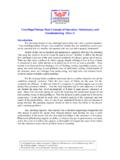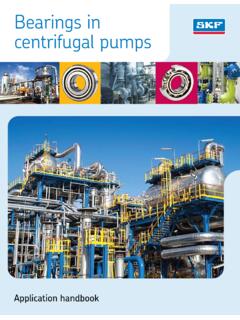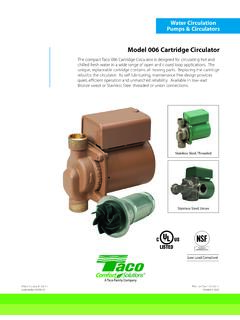Transcription of OPERATION & MAINTENANCE MANUAL for DOUBLE …
1 OPERATION & MAINTENANCE . MANUAL . for DOUBLE SUCTION. SPLIT CASE PUMPS. PATTERSON PUMP COMPANY. A SUBSIDIARY OF THE GORMAN-RUPP COMPANY. PO Box 790. 9201 Ayersville Road Toccoa, Georgia 30577. Telephone: 706-886-2101. Fax: 706-886-0023. SAFETY PRECAUTIONS. WARNING. Do not operate this equipment in excess of its rated speed or other than in accordance with the instructions contained in this MANUAL . The equipment has been found satisfactory of the conditions for which it was sold, but its OPERATION in excess of these conditions may subject it to stresses and strains which it was not designed to withstand. For equipment covered by this instruction book, it is important to observe safety precautions to protect personnel from possible injury. Among the many considerations, personnel should be instructed to: avoid contact with rotating parts avoid bypassing or rendering inoperative any safeguards or protective devices avoid extended exposure in close proximity to machinery with high noise levels use proper care and procedures in handling, lifting, installing, operating and maintaining the equipment do not modify this equipment consult factory if modification is deemed necessary do not substitute for repair parts which can be provided by the equipment manufacturer.
2 Safe MAINTENANCE practices with qualified personnel are imperative. Failure to heed this warning may result in an accident causing personal injury. TABLE OF CONTENTS. SECTION I: General 1. SECTION II: Storage & Protection .. 1. SECTION III: Installation 3-1 2. 3-2 Foundation .. 2. 3-3 2. 3-4 Alignment .. 3. 3-5 Grouting .. 6. 3-6 Piping .. 6. SECTION IV: OPERATION 4-1 7. 4-2 Shutdown .. 9. 4-3 Minimum Flow 9. SECTION V: MAINTENANCE 5-1 10. 5-2 Stuffing Box .. 11. 5-3 Wear Ring 11. SECTION VI: Repairs & Replacement 6-1 To Remove Rotor .. 15. 6-2 Disassembly of Rotating 15. 6-3 To Remove Impeller 16. 6-4 Inspection .. 16. 6-5 19. Locating OPERATION Difficulties .. 20-21. Recommended Spare 22. SECTION I. GENERAL INFORMATION. This MANUAL covers the installation, OPERATION and MAINTENANCE of Patterson Pump horizontal split case pumps.
3 The pump is a centrifugal, single stage, DOUBLE suction type. When properly installed and when given reasonable care and MAINTENANCE , centrifugal pumps should operate satisfactorily for a long period of time. Centrifugal pumps use the centrifugal force principal of accelerating the liquid within a rotating impeller, and then collecting it and converting it to pressure head in a stationary volute . The pump consists of two assemblies: 1. casing assembly or stationary part 2. Rotating element or moving part This casing is split along the horizontal centerline of the pump shaft, suction and discharge nozzles both being located in the lower half. With this arrangement, it is not necessary to disconnect suction or discharge piping to make repairs to, or replace the rotating element.
4 Upper and lower half casings are bolted together and doweled to maintain a smooth volute contour inside the pump. Supporting feet are integrally cast in the lower half casing and are drilled for bolting and doweling to base plate. Bearing brackets form a drip pocket for collecting stuffing box leakage and are provided with drilled and tapped connections for draining. The brackets also contain an overflow hole to release the water before it reaches the shaft, in case drain piping should become clogged. Suction and discharge flanges are drilled and tapped for gauge connections. Pump suction and discharge nozzles are drilled and tapped on the underneath side for complete pump drain. Wear rings are provided to minimize internal bypassing of the liquid being pumped, and to better efficiency, as well as to reduce the replacement of major components (such as casing and impeller).
5 SECTION II. STORAGE & PROTECTION. All pumps are shop serviced and ready for OPERATION when delivered, but there is occasions when considerable time elapses between the delivery date and the time the pump is put into OPERATION . Equipment, which is not in service, should be kept in a clean, dry area. If equipment is to be stored for long periods of time (six months or more), the following precautions should be taken to insure that the equipment remains in good condition. 1. Be sure that the bearings are fully lubricated. 2. Unpainted-machined surfaces, which are subject to corrosion, should be protected by some corrosive resistant coating. 3. The shaft should be rotated 10 to 15 revolutions by hand periodically in order to spread the lubricant over all the bearing surfaces.
6 Suitable intervals are from one to three months, depending on atmospheric conditions, etc. In order to insure that the pump shaft does not begin to sag, do not leave the shaft in the same position each time. 1. Section II Storage & Protection Continued 4. Space heaters on motors and controllers should be connected and fully operable if atmospheric conditions approach those experienced in OPERATION . Consult instruction manuals for other precautions concerning storage of individual components of pumping unit. 5. Fresh lubricant must be applied to bearings upon removal of equipment form storage. SECTION III. INSTALLATION. 3-1 Location: Several factors should be considered when selecting a location for the pumping unit (pump, base, drive, and coupling).
7 The unit should be accessible for both inspection and MAINTENANCE . Headroom should be provided for the use of crane, hoist or other necessary lifting devices. The pump should be located as close as possible to the liquid supply so that the suction line is short and direct. Location should require a minimum of elbows and fittings in the discharge line to minimize friction losses. The unit should be protected against flooding. 3-2 Foundation: The foundation should be sufficiently substantial to absorb vibration and to form a permanent rigid support for the base plate. Concrete is most widely used for foundation. Before pouring the foundation, locate anchor bolts per outline drawing. Allow for 3/4 inch to 1 1/2 inch of grout between foundation and base plate.
8 The top surface of the foundation should be roughened to provide a good bond for the grout. 3-3 Mounting: WARNING!!! Do not attempt to lift entire unit using lugs provided on either pump or motor only. Such action may lead to failure of the lugs and possible damage to the unit or injury to personnel. Lift unit with slings around the base plate, or by attaching cables to the lifting lugs on both the pump and the motor. Coupling halves should be disconnected when mounting the pumping unit on the foundation. Wedges should be used to support the unit at the time of grouting. Wedges should be located adjacent to anchor bolts (one on each side of bolt) and midway between bolts. Adjust the wedges to raise or lower the unit as required to align suction and discharge flanges to piping and to level the base plate.
9 Leveling bolts made of cap screws and nuts are useful when leveling large base plate, but should not replace shims or blocks for supporting the load. After unit has been in OPERATION for about a week, check alignment. After making any required adjustments, dowel pump and motor to base. 2. Section III Installation Continued 3-4 Alignment: The pump unit has been manufactured to allow field alignment. The unit must be properly aligned at the time of installation. Reliable trouble-free and efficient OPERATION of a unit depends upon correct alignment. Misalignment may be the cause of noisy pump OPERATION , vibration, premature bearing failure, or excessive coupling wear. Factors that may change the alignment of the pumping unit are settling of the foundation, springing of the base plate, piping strains, a shift of the pump or drive on the foundation.
10 When checking coupling alignment, remember flexible couplings are not intended to be used as universal joints. The purpose of a flexible coupling is to compensate for temperature changes and to permit end movement of the shafts without interference with each other. Two types of misalignment may exist: parallel misalignment and angular misalignment. Limits of misalignments are stated in the coupling manufacturer's instructions, but should be kept to a minimum for maximum life of equipment components. To check coupling alignment, the following procedure should be followed: 1. Set the coupling gap to the dimension shown on the outline drawing. 2. Check for parallel misalignment by placing a straight edge across both coupling halves at four points 90 apart.




